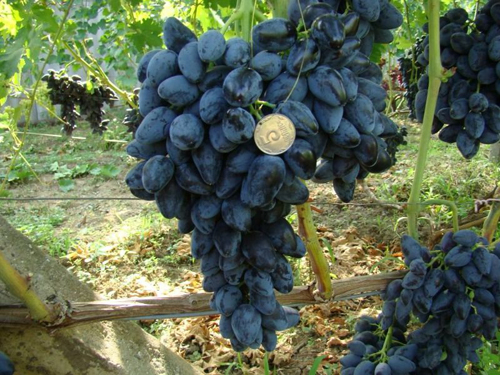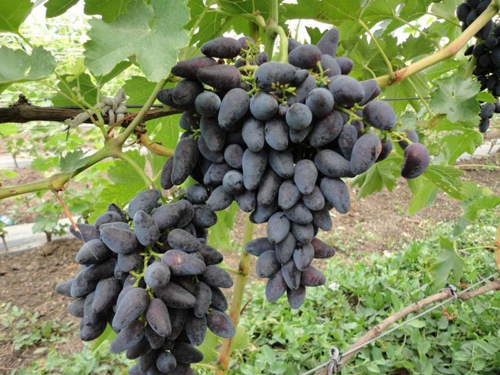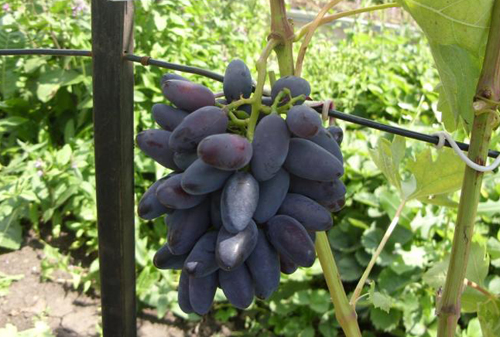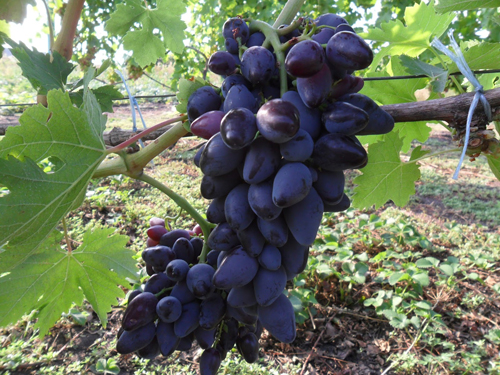Viking grape variety
It just so happened in our country in recent decades that the main work on the development of new varieties and hybrid forms of grapes instead of various research institutes was undertaken by amateur enthusiasts. At the same time, their business turned out to be so widespread that by now the winegrowers simply run up their eyes from the variety of table forms, the planting material of which is offered on the market. And even if amateur breeding has its drawbacks, in particular, the main emphasis on the aesthetic and gastronomic qualities of grapes and the secondary emphasis on economic ones, it is thanks to her that we today have the opportunity to have a truly amazing choice from varieties of any colors, tastes, shapes and sizes of bunches and berries. as well as the timing of the ripening of the crop.

At the same time, similar processes are taking place not only in domestic viticulture - in neighboring states, their national breeders are also actively working on new masterpieces, and their offspring are of no less interest. One of the most productive and renowned researchers in Ukraine is the Zaporozhye winegrower Vitaliy Zagorulko. On his account, there are already many dozens of wonderful grape hybrids that he has developed, some of which have received the right to officially be called varieties, having passed a full-fledged variety test and being entered in the corresponding state register. Moreover, some of Vitaly Vladimirovich's brainchildren had a chance to obtain official approval for use not only in their homeland, but also in Russia, which is further evidence of the dignity of his work. And this is even without taking into account the numerous victories at various industry exhibitions and competitions that the breeder can boast of.
Surprisingly, Zagorulko managed to achieve all these achievements without even having a specialized education, but having comprehended the nuances of a very complex craft only by his perseverance and work. He began to take his first steps in viticulture in the 80s of the last century, and after 10-15 years he became interested in crossing various varieties, sowing hybrid seeds, followed by selection and reproduction of the most promising forms. In his work, he, like most hobbyists, uses varieties with a functionally female type of flower, convenient for controlled cross-pollination. One of the favorite maternal forms at the same time is Red Rapture, also known as ZOS-1, of the selection of the All-Russian Research Institute of Life Sciences named after V.I. ME AND. Potapenko. With his help, Vitaly Zagorulko developed a number of hybrids, including the Viking table grape, which has already become popular. It is distinguished by a very early ripening period, large-fruited, pleasant taste and color of berries. He inherited some of these positive properties from his second parent, the Moldovan Codryankithat was used as a pollinator. But our hero does not differ in high yield, resistance to frost and disease, referring in this regard to the category of middle peasants. However, this does not prevent him from enjoying great interest among winegrowers, having managed to acquire an impressive army of his fans in more than 10 years since his birth, although he has enough critics.

Agrobiological characteristics
The bushes are highly vigorous. The leaves are large, rounded or extended in width, bright green, five-lobed with a strong degree of dissection. The surface of the leaf blade is reticulate-wrinkled. The upper side notches are very deep, closed with an ovoid lumen, the lower notches are much smaller, they can be varied in shape, but, as a rule, they are open slit-like or have the appearance of an inclined angle. The petiole notch is open, lyre-shaped or vaulted with a flat or slightly pointed bottom.Petioles are long, green, in good light - with a reddish tint at the base. The denticles along the edge of the vine are medium to large in size, triangular with a wide base, noticeably convex edges and sharp tops. The Viking's flowers are bisexual, but there are problems with pollination, which is why the variety often has cases of peeling berries in unfavorable years for flowering. Vegetative shoots are colored green with longitudinal anthocyanin stripes, when ripe they turn brown. Ripening of the vine occurs early and flawlessly.
Bunches with good agricultural technology grow large, with a maximum weight of up to 1 kg, medium - 500-700 grams, conical, moderately loose. Crests are strong, medium and above medium length, green in color. With insufficient pollination, grape berries can be of different sizes, but in most cases they are quite aligned, nipple-shaped, 33-35 mm long, 21-23 mm in diameter in the wide part, weighing from 8 to 13 grams, dark blue with a thick gray prune bloom on surface. Due to their relatively free arrangement in the hand, they are not deformed or damaged against each other. The pulp of the variety is dense, crunchy, very sweet with a rich dessert taste. Winegrowers often discover plum, sometimes cherry tones when tasting their Viking, although many of these specific features are not noticed behind him. A characteristic feature of the hybrid is a fast and high sugar accumulation, but this indicator may differ for grapes within a bunch. On average, the content of glucose and fructose in berry juice reaches 19-21 g / 100 ml, and even higher. There are no objective data on titratable acidity, but the sugar-acid ratio in taste is very harmonious. The peel is easy to chew, it is practically not felt when eating. The seeds are small, and with the normal size of the grapes, they practically do not affect gastronomic assessments. Overall palatability, according to most winegrowers, is well above average.

The harvest of this variety is successfully used for fresh consumption, as well as for the preparation of homemade canned food - juices, compotes, preserves and jams. The processed grapes provide a very beautiful color and taste to the product. Fresh - it is in very good demand in the market, where at the time of its appearance there is very little competition from other dark-colored varieties. The high interest in it is primarily influenced by the excellent presentation, and after tasting, indifferent buyers do not remain at all. In addition, the harvested Viking clusters have high transportability, allowing them to be moved over long distances without damage. Sufficient keeping quality is also an important factor, because thanks to it, the crop can be sold and consumed independently for a long time. It is also impossible not to mention the possibility of making quite good homemade wine from sufficiently sweet grapes, which can be a way out of the situation in the event of massive cracking of berries in unfavorable years for ripening. Many winegrowers have tested this possibility by their own experience and confirm the good quality of the resulting drink.
The grapes are very early maturing. The growing season from the beginning of budding to the onset of removable ripeness lasts only 100-110 days. The sum of active temperatures required by the Viking is also small - 2150-2250 ° C, which allows it to be grown in far from viticultural regions of central Russia, Siberia and the Far East. In these regions, it can pick up a little less sugar than in the south, but at the same time remain quite tasty and attractive in appearance. For cultivation in harsh conditions, it is only necessary to provide good protection against winter cold, since the frost resistance of the variety (-21 ° C) is not the most outstanding even for the southern regions.

Productivity is also not the Viking's strongest point.Already 10-15 kilograms per bush can be considered a good result for him, but many growers complain that they do not even achieve this. Moreover, there are often cases when, after several good seasons, plants decide to "rest" for one or two years, showing very little productivity. This is due to the low fruitfulness of shoots in this variety of grapes, only every second of which forms generative organs. Some "lucky" owners of the hybrid even got rid of it, because according to their bitter admission, "one leaf grows on it." It is worth noting here that you should not blame the plants. It is possible that the disappointed growers themselves did not take into account the specifics of the form, which is the infertility of the first buds, which is why a short pruning can lead to the described symptoms. In addition, yields can be seriously affected by the insufficient pollination to which the hybrid is prone, and the subsequent peeling of the berries, or excessive loosening of the bunches. It should be noted that such a gap in agrobiology is not catastrophic, and can be corrected with special measures.
Some advantage in a difficult situation with the productivity of the variety can be the fact that due to the low fertility of the Viking shoots it is almost impossible to overload the crop, which means that efforts to thin out the inflorescences are practically not required.
After ripening, the grapes can continue to hang on the vine for a long time, as much as the local climatic conditions allow, and first of all, the absence of frost, when it comes to the northern regions. But, at the same time, it must be borne in mind that with prolonged rainy weather or a sharp change in soil moisture, Viking berries often crack, after which they become suitable only for processing or independent use in an extremely short time. With regard to the susceptibility of a ripe crop to wasps, the situation here is clearly better - thanks to the strong skin of the grapes, they staunchly resist the attacks of these insects, and therefore no serious protection measures are required against them.
Agrotechnical features
As it has already become clear, our hero, having a relatively high taste and excellent marketability of the crop, at the same time is quite difficult to grow, requiring increased attention and consideration of a number of specific features.
The wide geography of the hybrid's distribution indicates that various soils are suitable for cultivation, ranging from fatty southern chernozems to podzolic soils of the Russian Non-Chernozem region. At the same time, on acidic northern soils, it is imperative to take measures to equalize the pH value, because high acidity has a depressing effect on many grape varieties and this variety in particular. In addition, cold slopes and lowlands, damp and wetlands, areas with a high level of groundwater, salt marshes and dry sandy soils in regions with a clear lack of rainfall and lack of irrigation are traditionally not suitable for Viking cultivation. In the north, with the threat of a lack of heat for ripening grapes, plants are placed in a wall culture on the southern side of various buildings, protected from cold air currents. In such conditions, the bushes feel more comfortable than in open areas, and the sum of active temperatures is somewhat increased here.
The vineyard is laid in two ways - by rooting the cuttings of the hybrid itself or by grafting it onto a special phylloxera-resistant stock. The first option is suitable for regions not infected with a malicious soil pest - root phylloxera, and allows even an inexperienced grower to easily propagate the variety with his own planting material. However, those who are less fortunate, and soil aphids have already settled on their plots, will have to plant grafted seedlings.However, there is also a plus here - if you plant a Viking on a stock that inhibits the vegetative growth of a bush (for example, such as Chassela x Berlandieri 41B or Berlandieri x Riparia CO4), then one can hope for an improvement in the generative component, and therefore an increase in yield. When planting by any of the described methods, a sufficient amount of mineral and organic fertilizers is applied to the pits, and during the first years of development, regular and abundant watering is provided. Vigorous grape bushes need significant space for themselves, and therefore it is not recommended to thicken the planting, providing a minimum of 4.5-5 sq. meters of food area per bush.
Practically in all growing regions, except perhaps the Crimea and the Black Sea coast of the North Caucasus, the variety is cultivated in a covering culture, for which it is formed according to special squat patterns, the most popular of which in domestic viticulture are a multi-arm fan and an inclined cordon. They are necessary in order to remove the grape vine from the trellis every autumn without damage, covering it with earth or special insulation. The choice of material depends on the frost hazard of the climate. An earthen shelter is suitable for relatively mild winters with minimum temperatures down to -26 ... -28 ° С. In the same cases, tunnel film structures can be used, built on the principle of mini-greenhouses over a vine laid on the ground. Under them, the temperature in winter is usually 6-8 degrees higher than in the open air.
In the most severe conditions, you will have to work hard on warming wintering grapes. The above-ground part of the bush is carefully insulated with natural heat-insulating materials - straw, peat, wood shavings, needles or reeds, and then additionally undergoes waterproofing using wooden shields, film or roofing material to protect against the penetration of melt moisture, wetting the vine and drying out the eyes on it. The material used as insulation during the next growing season can be used as a mulch layer to prevent excessive drying out of the soil during dry periods. In the most favorable regions for viticulture of our country, where the thermometer does not drop below -21 ° C in winter, you can try to cultivate Viking on a high stem, without shelter in the cold season. With such a formation, you can count on significantly better indicators of large-fruited and yield of the variety as a whole.
Pruning fruit-bearing grapes and then green operations is a cornerstone in ensuring sufficient productivity. As already mentioned, the first buds on its shoots are not fruitful, which is why pruning should be carried out very long - for 12-15 buds. The total load on the bush can reach 50−55 eyes, but this requires a thorough breakdown of all sterile shoots after the start of the growing season. Ideally, after this procedure, the standard 22-25 fruiting shoots should remain on the bush, and it is usually not necessary to remove extra brushes on them. These figures are relevant for mature, well-developed plants. Young bushes just beginning to bear fruit are loaded much more moderately.
Due to the problems arising from pollination, winegrowers are advised to arm themselves with puffs during the flowering of the variety to help their wards in sufficient fertilization of the inflorescences. Theoretically, in such cases, treatment with gibberellic acid can help, however, unfortunately, there is no reliable information about its successful application on the Viking.
Careful regulation of the water balance of the soil will help to reduce the cracking of grapes during ripening.Its best option is regular irrigation of the vineyard, but in the absence of such an opportunity, abundant mulching of the soil under the bushes will show certain results. In addition, it is necessary to study the peculiarities of the climate, and with a high risk of prolonged rains in late summer - early autumn, do not overexpose the crop on plants.
Fight against fungal diseases should be carried out according to the schemes of medium-resistant varieties. In these cases, 2-3 preventive treatments are usually carried out at the beginning of the season, when pathogens are especially harmful, and then act according to the situation, responding to isolated outbreaks of individual diseases. In addition to fungicidal protection, acaricidal protection should be provided, since grapes can be affected by spider mites and itching. To regulate the number of these pests, it makes sense to carry out treatment with sulfur-containing preparations that are also active against powdery mildew. The instructions should be followed carefully, as spraying at extremely low temperatures will not be beneficial, and at high temperatures it can burn the plants.
In general, the Viking, although it cannot be called unpretentious, is not overly pampered either. He, like many other varieties, has its own pros and cons, and, of course, has a right to exist, as many of his fans are absolutely convinced.








